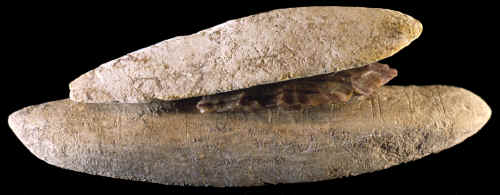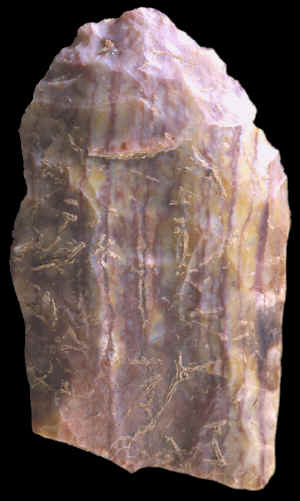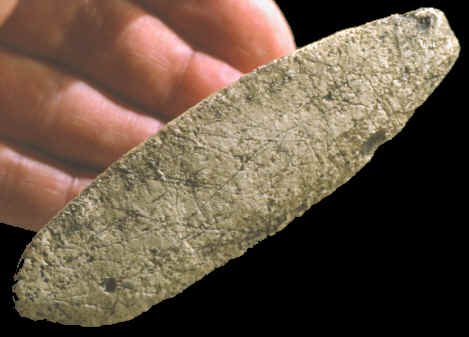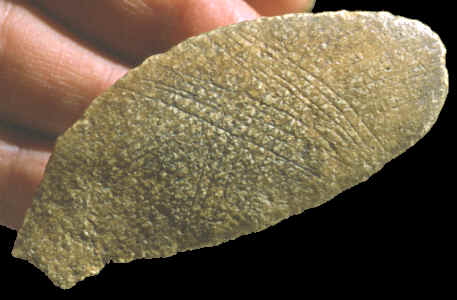|
PAGE
2 CONTINUED
FROM PAGE 1
GAULT SITE
ENGRAVED STONES
CLOVIS
CULTURE
WILLIAMSON COUNTY, TEXAS
EST. 11,500
TO 11,0OO YEARS AGO
PAGE 2 OF 2 PAGES
COPYRIGHT
SEPTEMBER 30, 2003 PETER A. BOSTROM

CLICK ON PICTURE FOR LARGER IMAGE
"STACKED" AS
FOUND
GAULT SITE
WILLIAMSON COUNTY, TEXAS
PRIVATE COLLECTION
This cache of three artifacts were found in this position by
David Olmstead on the Gault site. He found them several years ago while digging
there.
The larger stone on the bottom is engraved on one site with a
"checkerboard" pattern. The one on the top is engraved
with what seems to be random designs. The artifact in the center is a
heavily resharpened Clovis point made of Alibates chert. The
largest engraved
stone, on the bottom, measures 5 5/8 inches (14.3 cm) long and 1 1/2 inch (3.8 cm)
wide. |
|
|
Engraved
stones and pebbles are fairly rare in North America. They are especially
rare from the earliest Paleo-Indian sites. Collins and Hester report in
"Interpreting the Clovis Artifacts from the Gault Site" that
"Clovis-age engraved stones are presently known from only two sites
in the western hemisphere besides Gault, one specimen each from the
Clovis site in eastern New Mexico and the Wilson-Leonard site just north
of Austin, Texas". The Gault site has produced at least 30 engraved
stones. The engraved stones from the Gault site are engraved with almost
exclusively geometric patterns.
|
|

CLICK ON PICTURE FOR LARGER IMAGE
CLOVIS POINT
GAULT SITE
WILLIAMSON COUNTY, TEXAS
PRIVATE COLLECTION
This is the Clovis point that David Olmstead found
"sandwiched" in-between two engraved stones on the Gault
site. One ear is damaged and it's been extensively resharpened to
the point where it was probably no longer useful as a spear point.
The configuration of it's placement in between two engraved stones
is interesting. But the reason why it was left in this position over
11,000 years ago can only be theorized. This Clovis point is made
of Alibates chert and measures 2 1/4 inches (5.7 cm) long. |
|
|
On
two sites in North Carolina, Hardaway and Doerschuk, as many as 272
engraved slate fragments and water worn pebbles were found. The Hardaway
site produced most of them. The majority of the designs were either random
scratches or simple geometric patterns. One example that is illustrated
in the Hardaway site report has a "checkerboard" design.
Hardaway and Doerschuk are multi-component sites with their earliest horizons
extending well into the Archaic period. J.L. Coe reports that "In
the excavated area, sixteen engraved slate fragments and five engraved
pebbles were found at various levels, but their cultural association
remains as much an enigma at the Hardaway site as was true at the
Doerschuk site".
|
|

CLICK ON
PICTURE FOR LARGER IMAGE
ENGRAVED STONE
"CHECKERBOARD" DESIGN
GAULT SITE
WILLIAMSON COUNTY, TEXAS
PRIVATE COLLECTION
This Engraved stone was found in direct contact with an extensively
resharpened Clovis point made of Alibates chert. The fluted point
was "sandwiched" (see above picture) in between this
stone, which was on the bottom and another smaller engraved stone
that was on the top.
This stone is engraved on one side with a
"checkerboard" design. There are several pairs of vertical
parallel lines that bisect several other pairs of horizontal
parallel lines at approximately 90 degree angles. This engraved
stone measures 5 5/8 inches (14.3 cm) long and 1 1/2 inch (3.8 cm)
wide. |
|
|
An
anthropology scholar who traveled the world beginning in the 1930's, named Carl Schuster, studied endless varieties of geometric
patterns, symbols and designs. One explanation he gives for some of
those patterns are that they represent clothed figures. He calls them
"robed figures." He believed that many of these engraved
stones, that that he documented all over the world from all time
periods, represent ancestor figures. Some engravings, he believed,
represented clothing worn on stylized ancestor figures.
|
|

CLICK ON
PICTURE FOR LARGE, ORIGINAL ARTIFACT, IMAGE
ENGRAVED STONE (cast)
GAULT SITE
WILLIAMSON COUNTY, TEXAS
PRIVATE COLLECTION
This engraved stone is engraved on both sides with random designs.
The lines bisect other lines at all angles. It was found by David Olmstead
while digging on the Gault site several years ago. He found it
laying on top of an extensively resharpened Clovis point made of Alibates
chert. The Clovis point was also lying on top of another
larger engraved stone. This engraved stone measures 4 inches (10.1 cm) long and
1 1/4 inches (3.1 cm) wide. |
|
|
In
Australia, the churinga (or tjurunga depending on spelling) engraved
stones (also wood) are individually linked with legendary ancestors
along with a myth or tale connected with the location where they are
hidden. Carpenter writes in "Social Symbolism In Ancient &
Tribal Art" that "Pebbles were incised the way human flesh was
scarified, and scratched the way skin garments were scratch-decorated.
Then both pebbles and garments were dusted with red ochre. Australian
aborigines incised stones 'to make them bleed' and filled those
incisions with ochre." Carl Schuster believed that "dressed
stones represented, originally, ancestral spirits, comparable in many
ways to Australian churingas / tjurungas.
|
|

CLICK ON
PICTURE FOR LARGE, ORIGINAL ARTIFACT, IMAGE
ENGRAVED STONE (cast)
GAULT SITE
WILLIAMSON COUNTY, TEXAS
PRIVATE COLLECTION
This engraved stone was found by David Olmstead approximately 5 feet
(152.4 cm) below the surface on the Gault site. This example is
engraved with several parallel lines that extend lengthwise along
with other parallel lines that cut across them at three different angles.
Engraved stones like this example have been found
on Stone Age sites around the world. They have been found on
Paleolithic sites in Europe, on Early Neolithic sites in Japan, and
very early sites in Australia. This engraved stone measures 2 3/4
inches (7 cm) long. |
|
|
The
specific meaning behind each engraved stone has been lost. Much of what
is known are basic concepts. For example, if
you look closely at many of the different cultural designs around the
world, especially cloth, what seems like solid textures, are really tiny
repeated separate designs that are attached to each other, each one representing an ancestor. It's like
a primitive mathematical formula that represents an endless chain of
human life.------------
"Sit beside me, and do as I do", says the basket-maker to her
tiny daughter. "Stand behind me, and do as I do', says the dancer
to the novice. Not tombs, not libraries, but living people are the great
preservers." Carpenter and Schuster
|
|
"REFERENCES"
1963,
Tindale, Norman B. and Lindsay, H.A., "Aboriginal Australians",
p.105.
1964, Coe, Joffre Lanning, "The Formative Cultures of the
Carolina Piedmont", The Doerschuk site, p. 53 and The
Hardaway site, pp. 81 & 82.
1984, Munn, Nancy D., "Religion In Aboriginal Australia",
The Transformation of Subjects Into Objects In Walbiri and
Pitjantjatjara Myth, p. 66.
2000,
Wisner, George, "Texas Site Suggests Link With Europe's Upper
Paleolithic," Mammoth Trumpet, Vol. 15 # 1.
2001, Collins, Michael B. & Hester, Thomas R., "Research--The
Gault Site--Site Description," Web site for "Texas
Archaeological Research Laboratory."
|
|
HOME
ORDERING |




